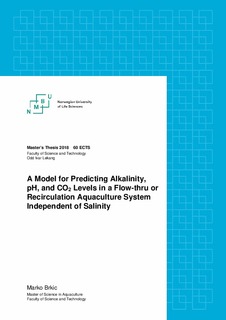| dc.contributor.advisor | Lekang, Odd Ivar | |
| dc.contributor.author | Brkic, Marko | |
| dc.date.accessioned | 2018-09-10T11:15:18Z | |
| dc.date.available | 2018-09-10T11:15:18Z | |
| dc.date.issued | 2018 | |
| dc.identifier.uri | http://hdl.handle.net/11250/2561749 | |
| dc.description.abstract | Carbon dioxide is one of the limiting factors for construction of recirculation aquaculture system in the fish farming today. The level of carbon dioxide in the water heavily depends on fish metabolism and water chemical composition. Carbonate chemistry itself is complicated because carbon dioxide exists in different forms in the water. Alkalinity and pH are the two main factors that are affecting the total available carbon dioxide and its form, which was described by Kenneth S. Deffeyes in the mid-1960s.
Carbon dioxide affects the fish health, behavior and welfare in recirculation aquaculture systems, and it is important to know in every production step how much is produced and how much is spent. The developed model uses fish metabolism contribution and Deffeyes diagram chemistry explanation, to predict levels of carbon dioxide in different components of the RAS system. The model is designed for simple use in a user-friendly Excel sheet and for mobile phone application. The users are not required to understand the complex mathematics and chemistry behind the model to use it effectively. The users need to put values obtained from different measurements on the fish farm into the dedicated boxes in the program.
The model is still in its developing stage, meaning that it needs further testing and more results from fish farms to confirm efficiency and robustness of the model. There are a number of other possibilities for developing and the model can include for example heavy metal precipitations, medicals precipitation or particle removal. With different add-ins, farmers or engineers can predict the maximal capacity of the farm with the inlet values that they get from the water quality, fish size, and the type of the diet for the specific fish category.
The Excel sheet and an online mobile application allow users to get accurate predictions with a single click, without fear that it will affect the fish health in the running system. The results obtained by the application simulation can then be used for fine-tuning of the equipment installed on the fish farm and to optimise regarding fish performance and the used feed. | nb_NO |
| dc.language.iso | eng | nb_NO |
| dc.publisher | Norwegian University of Life Sciences, Ås | nb_NO |
| dc.rights | Attribution-NonCommercial-NoDerivatives 4.0 Internasjonal | * |
| dc.rights.uri | http://creativecommons.org/licenses/by-nc-nd/4.0/deed.no | * |
| dc.subject | RAS | nb_NO |
| dc.subject | Aquaculture | nb_NO |
| dc.subject | Carbon dioxide | nb_NO |
| dc.title | A model for predicting alkalinity, pH, and CO2 levels in a flow-thru or recirculation aquaculture system independent of salinity | nb_NO |
| dc.type | Master thesis | nb_NO |
| dc.description.localcode | M-AA | nb_NO |

